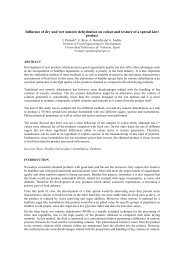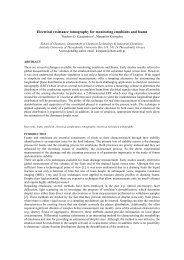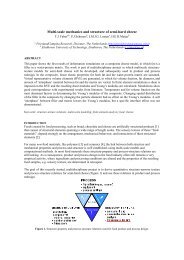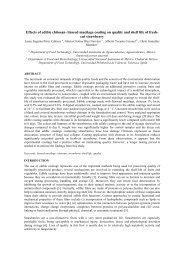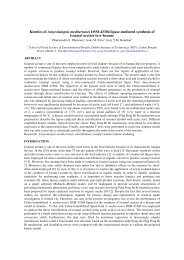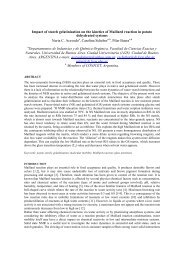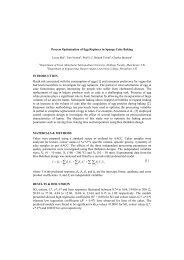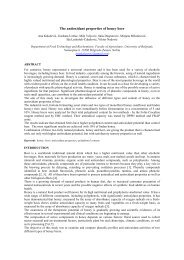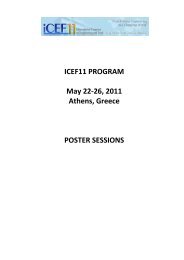Osmo-dehydration of fruits
Osmo-dehydration of fruits
Osmo-dehydration of fruits
Create successful ePaper yourself
Turn your PDF publications into a flip-book with our unique Google optimized e-Paper software.
aqueous solutions <strong>of</strong> salts and sugars, and food systems, like dough <strong>of</strong> various cereal flours [6,7]. The kind <strong>of</strong><br />
equipment used, namely, a TG-DSC combined instrument, allows extention <strong>of</strong> the investigation to various<br />
temperatures.<br />
MATERIALS & METHODS<br />
The Knudsen TG, designed by Schiraldi and Fessas [6], allows the direct determination <strong>of</strong> water activity. The<br />
thermo-balance cells are replaced with Knudsen cells, namely closed cells the cover <strong>of</strong> which has a 20 m<br />
orifice through which water molecules are pumped out under high dynamic vacuum (pext ≈ 0). In isothermal<br />
conditions the flux <strong>of</strong> water through the orifice, J, is proportional to the water partial pressure, p W , within the<br />
cell,<br />
dmW<br />
J = ∝ ( pW<br />
− pext<br />
) ≈ K ⋅ pW<br />
(1)<br />
dt<br />
where the constant K depends on the temperature and the size <strong>of</strong> the orifice and the flux J corresponds to the<br />
record <strong>of</strong> the time derivative <strong>of</strong> the thermo-gravimetric (DTG) trace.<br />
A separate experiment (at the same temperature and vacuum conditions) with a pure water sample produces a<br />
flux J* = K p W *, where p W * is the vapour pressure <strong>of</strong> pure water. The p W /p W * ratio is a good approximation<br />
for the value <strong>of</strong> water activity, a W , (or relative humidity, RH) <strong>of</strong> the sample considered. Because <strong>of</strong> the<br />
sample <strong>dehydration</strong> that takes place during the KTG run, the p W /p W * ratio decreases, while the mass drop is<br />
simultaneously recorded: this allows the direct evaluation <strong>of</strong> the residual sample moisture content versus RH,<br />
namely, the desorption isotherm.<br />
A single run therefore allows to draw the whole desorption trend, plotted in the plane (m W /m dm , RH), where<br />
the subscripts “W” and “dm” stand for water and dry matter, respectively, with reference to the trace <strong>of</strong> pure<br />
water recorded immediately before [6].<br />
These desorption trends are to be considered within the RH range actually experienced during an osmo<strong>dehydration</strong><br />
process, i.e. RH ≥ 0.8.<br />
The instrument used was a SETARAM TG-DSC111, Lyon, France, which allowed the simultaneous output<br />
<strong>of</strong> TG trace, namely mass loss-vs-time, its time derivative, DTG, and the relevant thermal effect. Thanks to<br />
such a coupling, the mass loss can be reliably attributed to the release <strong>of</strong> water if the mass-loss-rate/heat flux<br />
ratio has a value <strong>of</strong> about 2.2 J g-1, namely, the vaporization enthalpy <strong>of</strong> water [6], which is expected to hold<br />
also for water rich systems, like salt and sugar solutions, vegetables and <strong>fruits</strong>.<br />
Fuji cultivar apples, peeled and cut into spheres (d about 1.5 cm), were osmo-dehydrated at room temperature<br />
(~25°C) with three different sugar syrups <strong>of</strong> given water activity (a W = 0.89). The hypertonic syrup was<br />
continuously re-circulated through a peristaltic pump and the fruit-syrup mass ratio was kept at 1/8 (w/w);<br />
composition and water activity <strong>of</strong> the syrup underwent some detectable changes. Different treatment times<br />
were exploited (up to 6 h) in order to obtain samples at different <strong>dehydration</strong> levels. After the osmotic<br />
treatment, the samples were carefully and rapidly washed with cold water (details are reported in [8]). 40 mg<br />
mass samples were used for the KTG investigations.<br />
RESULTS & DISCUSSION<br />
In a osmo-<strong>dehydration</strong> process the dry matter <strong>of</strong> the sample increases, the RH <strong>of</strong> the fruit decreases and that<br />
<strong>of</strong> the hypertonic syrup increases, since the removal <strong>of</strong> water from the fruit is more than counterbalanced by<br />
the migration <strong>of</strong> sugars from the syrup toward the apple pulp. The process ends (after about 4 hour, in the<br />
present case) when fruit and syrup attain the same RH value.<br />
Since the intracellular water is sucked out <strong>of</strong> the fruit cells and displaced toward the intercellular regions and<br />
the surrounding medium, the RH <strong>of</strong> this is indeed a little higher at the end <strong>of</strong> the treatment.<br />
The starting samples <strong>of</strong> a Knudsen experiment must be in a steady state, i.e., with no neat water displacement<br />
between fruit compartments. During the isothermal <strong>dehydration</strong> the water fraction with the easiest access to<br />
the head space <strong>of</strong> the Knudsen cell determines the actual vapor pressure and therefore the RH detected. This<br />
means that RH gradients are soon formed between different fruit compartments. The relevant Knudsen trend<br />
therefore reflects quasi equilibrium states only when the effusion through the cell orifice is as slow as the<br />
displacement <strong>of</strong> water from one compartment to another.<br />
The desorption isotherm <strong>of</strong> non-treat fruit deals with a system the dry matter <strong>of</strong> which does not change. The<br />
release <strong>of</strong> water from the fruit is in this case limited by the diffusion <strong>of</strong> water through the cell walls. The fact



